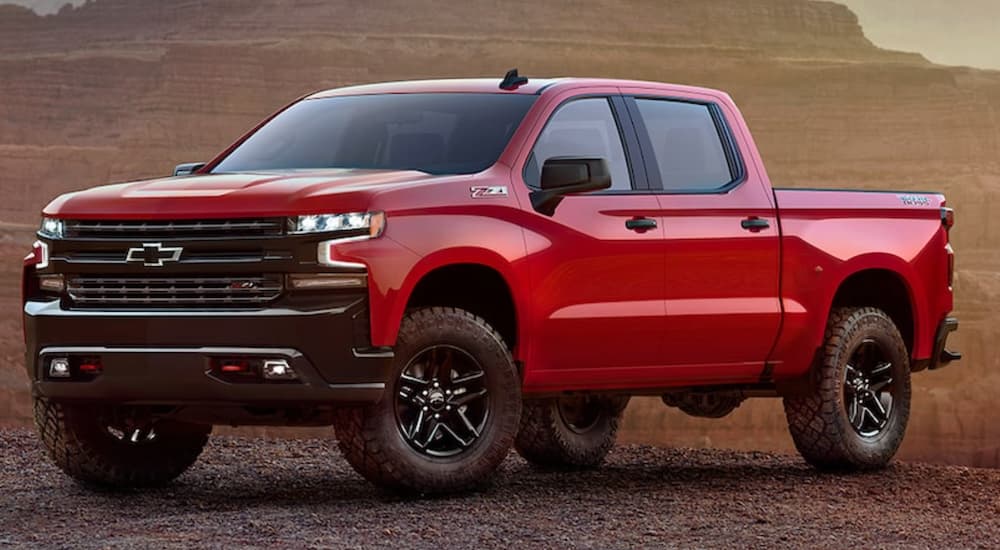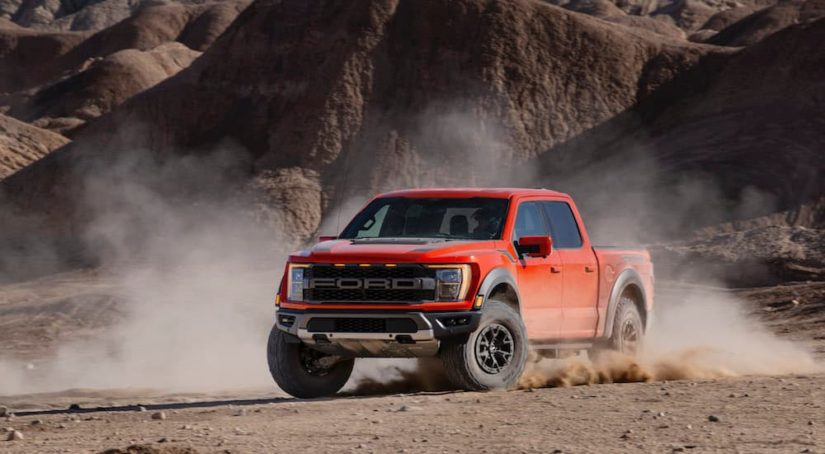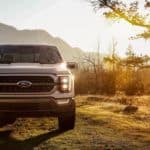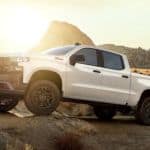Performance truck buyers don’t care as much about cabin niceties like leather and authentic wood trim; what they do care about is whether their rig will ably climb up the side of a mountain, ford a fast-moving river, or crawl around a rocky outcropping. Speed matters, too, especially across sandy desert terrain. Two category favorites–the 2021 Ford F-150 vs 2021 Chevy Silverado–compete for enthusiasts with trims designed specifically for off-roading.
Ford leaves the mud-soaked adventures to the able Raptor. Dubbed a “pickup truck on steroids” by the editors of Car and Driver, the Ford F-150 Raptor is at home traversing even the grittiest terrain. Chevy answers the challenge with a beast of its own, the Silverado 1500 LT Trail Boss. Outfitted with all the Z71 Off-Road Package’s goodies, the LT Trail Boss has a respectable skill set, but is it dynamic enough to knock the Raptor off its perch?
That question is best answered with a deep dive into each truck’s spec sheet, including a side-by-side comparison of standard and available off-roading features. We won’t make you wait until the last sentence to reveal our winner–it’s the F-150 Raptor by a mile. What we will do is break down why. It’s important, since owning either of these trucks requires buyers to part with well over $50k.
Trail-Dominating Capability
Differentiating a typical pickup truck from its performance-oriented alter ego first requires examining what’s under the hood. In the case of the F-150 Raptor, it’s easy to underestimate the 3.5-liter EcoBoost V6 simply because it’s not a massive big-block V8, but that would be a mistake. This particular V6 is a twin-turbo that outputs a trail-conquering 450 horsepower. Rounded out by a 10-speed automatic and a 3-inch diameter exhaust, this powertrain is built to impress.
Compare that with Chevy’s Silverado 1500 LT Trail Boss, a competing trim that’s offered with a choice of two powertrains: a standard 5.3-liter EcoTec3 V8 or a larger, more expensive 6.2-liter EcoTec3 V8. The former makes 355 horsepower and 383 lb-ft of torque, while the larger engine improves output to 420 horsepower and 460 lb-ft of torque. Neither matches the specs found on the Raptor’s more capable twin-turbo V6, however, which begs the question: why add weight only to get less power?
But the engines aren’t the full story here; let’s talk about tires. The shoes your performance truck wears can mean the difference between making it through, over, and around obstacles and getting stuck spinning your wheels in frustration. Ford’s Raptor comes standard with 35-inch tires, or buyers can opt for a set of upgraded 37-inch all-terrain tires to optimize trail handling capability. By comparison, the LT Trail Boss wears a set of 32-inch Mud-Terrain Goodyear Wrangler DuraTrac tires which look even smaller than they sound, thanks to the truck’s standard factory 2-inch lift that leaves a gaping hole between the tire and the fender.

Tech-Assisted Terrain Management
Perhaps the most compelling trail-ready feature on the 2021 Ford F-150 Raptor is Terrain Management System, a drive mode system that puts ride control one toggle away for the driver. The seven selectable drive modes, accessible via a switch in the cabin, include Slippery, Tow/Haul, Sport, Normal, Off-Road, Baja, and Rock Crawl. Each setting customizes traction, throttle, steering, shifting, and damping for optimal handling in the selected condition, taking much of the manual drudgery out of the process.
Rock crawling in a Raptor gets an added boost from the innovative Trail 1-Pedal Drive feature. Standard on all Raptor trims, Trail 1-Pedal Drive works best in Rock Crawl mode and lets drivers control throttling and braking solely with the gas pedal. Pressing the gas pedal creates forward motion, and removing your foot from the pedal initiates braking. Braking intensity adjusts in tandem with how far/fast the driver releases the throttle. It’s a lifesaver for longer, more treacherous trails.
Chevy outfits the Silverado 1500 LT Trail Boss with all the necessary off-roading gear, including skid plates, a factory two-inch lift, and available mud-terrain tires, but in a side-by-side comparison of equivalent terrain management technology, Chevy’s off-road 1500 trim falls short. Buyers will enjoy the standard Hill Descent Control and the electronic stability control, as well as the automatic locking differential. Unfortunately, you won’t find selectable drive modes or an equivalent to Ford’s Trail 1-Pedal Drive on the LT Trail Boss.
The Buzzword For 2021: Camera Views
The release of the 2021 Raptor ushered in generation three of Ford’s desert racing-inspired F-150, and with it came a plethora of advanced technologies that automate many of the systems off-roaders rely on for optimal performance. The buzzword is cameras, and both trucks employ them as real-time driver-assist tools. Easier trailer hook-up is a major benefit, as is the bird’s eye surround view for a quick check on upcoming obstacles on the trail. We love that the Raptor’s camera system offers up to a 4-way split view.
Ford devotes a substantial amount of real estate on the Raptor’s dash to the oversized 12-inch touchscreen, a decision that makes the most sense when buyers opt for the available 360-Degree Camera Package. Crisply display multiple live views fed by four cameras–one on the tailgate, one within the grille, and one each underneath the side mirrors–and even check on cargo with the bed-view camera. The companion digital driver cluster also displays key off-road data, such as steering angle and incline.
The LT Trail Boss also makes good use of strategically mounted cameras but does so on a much smaller 8-inch screen and in a much more limited fashion. A bed view camera is standard, and since Chevy’s Convenience Package II is also included, buyers will receive an upgraded HD Rear Vision Camera. Unfortunately, Chevy’s more advanced HD Surround Vision system, which includes the 360-degree camera, isn’t available at all on the LT Trail Boss.

Raptor or Trail Boss?
Unless you’re budget shopping for an off-road pickup, which is highly unlikely if your list of contenders includes either of these trucks, our money’s on the 2021 Ford F-150 Raptor. It has a higher base MSRP than the Silverado 1500 LT Trail Boss, but if you outfit the Chevy with the bigger engine and the optional driver-assist safety features that are standard on the Raptor, the price ticks ever closer to Ford’s more capable rig. Meanwhile, Raptor buyers can add luxury goodies like an 18-speaker B&O audio system that can’t be had on the Silverado.
Remember, even with the larger 6.2-liter V8, the Silverado 1500 LT Trail Boss can’t achieve the Raptor’s horsepower rating. So, regardless of any other comparisons, if max power is the goal, your choices narrow down to just one. Off-roading and desert racing aren’t considered extreme sports for no reason, so if zipping across a chunk of sandy desert or hitting the local trail for an afternoon of mud-soaked fun is your preferred leisure activity, be sure to choose the best tool for the job.
The 2021 Ford F-150 Raptor unapologetically combines rugged off-road-ready equipment with the latest technological advances to bring drivers a thrilling mountainside experience. It’ll even haul a pair of ATVs to tackle remote backcountry terrain. And when the time comes to get back to real life, the Raptor will comfortably get you and yours around town. Our recommendation? Keep a stepladder in the back for your little ones. After all, you’re still doing errands in a truck with over 13 inches of ground clearance.



